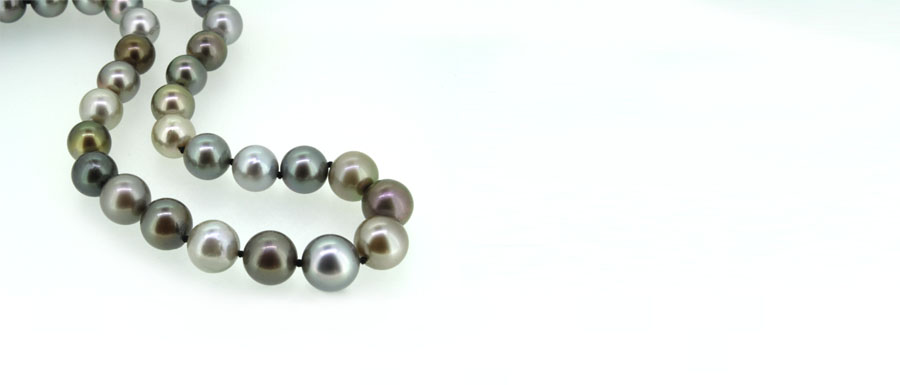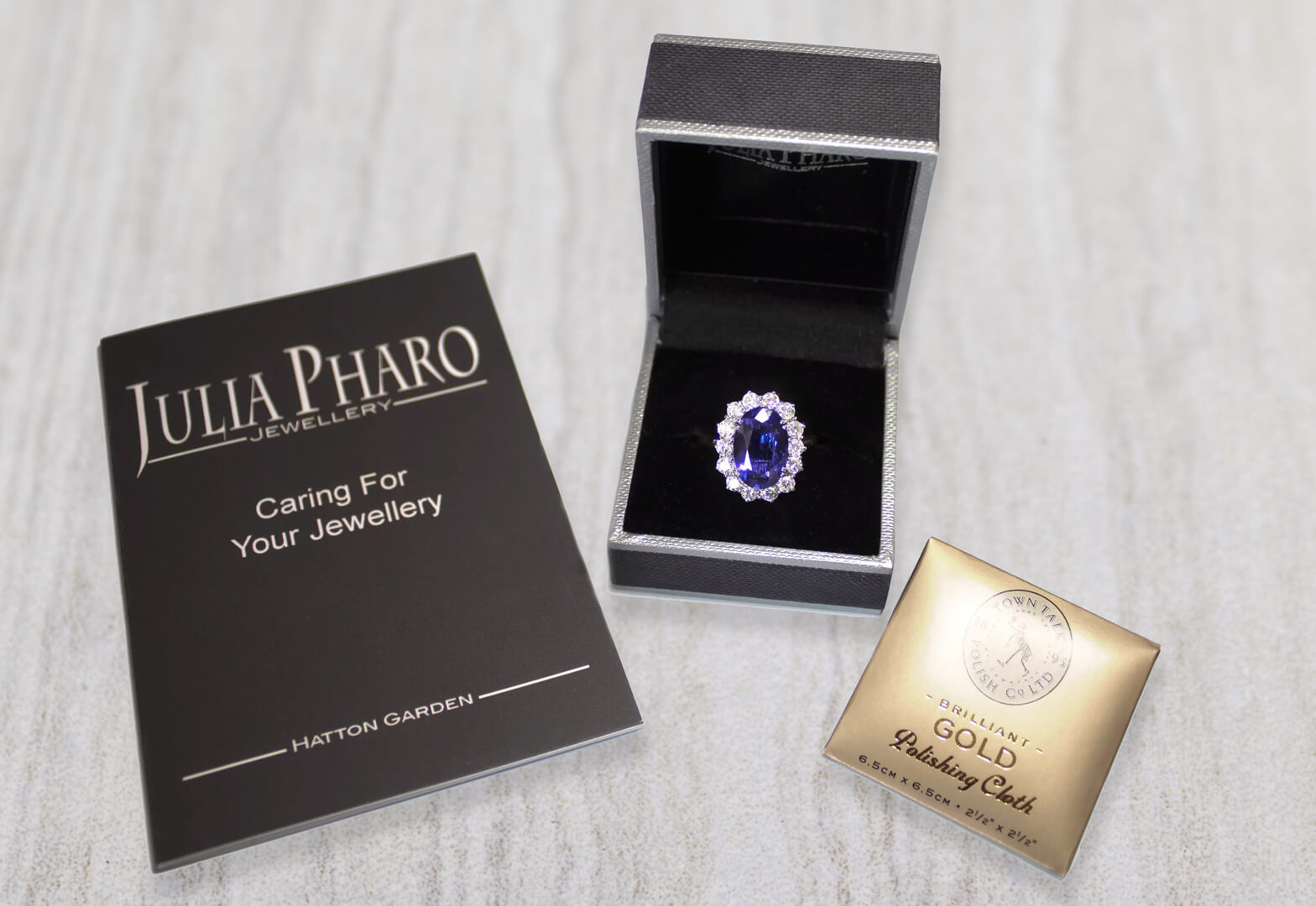
Jewellery Care
Top tips to keep your jewellery in tip top condition

Jewellery
Care
Top tips to keep your jewellery in tip top condition
It matters enormously to us that you’ll love, wear and enjoy your collection from Julia Pharo Jewellery for many years to come.
To this end, Julia has put together this helpful guide to enable you to care for your fine jewellery and always keep it looking its best.
Taking proper care of your jewellery is time well spent and will help ensure your jewellery will not only be loved for a lifetime but become a treasured family heirloom for future generations.
Should you require further help or advice in caring for your jewellery please do contact us - we’re always here to help!

Fine jewellery is made to be adored, worn and admired.
Following these simple steps will allow you to enjoy wearing your favourite jewellery to the fullest.
- Only apply lotions, cosmetics, hairsprays and perfumes prior to wearing, or after removing, your jewellery.
- Allow fragrances and hairsprays to dry and lotions to absorb into the skin prior to wearing your jewellery.
- Never wear your jewellery whilst showering, bathing or swimming. Some jewellery can be adversely affected by chlorinated water such as that found in swimming pools. The specialised glue used to secure pearls to precious metal fixtures can also be loosened in contact with water – so take particular care to remove such pieces prior to entering the water.
- Never wear your jewellery whilst working with household or industrial cleaning agents, ammoniated products, bleaches, abrasives or solvents. Even plain precious metal jewellery (such as Gold or Sterling Silver) can be adversely affected by many commonly available cleaning agents as well as chlorinated water. Gold can be particularly susceptible to damage in contact with household bleach.
- Pearls, Opals, Turquoise and other porous or treated gemstones can be particularly prone to being adversely affected by cosmetic products, household and industrial cleaning agents, ammoniated products, bleaches, abrasives, solvents and chlorinated water. Please take extra care! Always remove such rings prior to washing your hands or submerging your hands in water and never wear such jewellery whilst swimming, bathing or showering.
- Never wear your jewellery whilst involved in any physical activity that could increase the risk of your jewellery being knocked, caught, scratched, scuffed or damaged. Activities which will need a re-think whilst wearing your jewellery include working out at the gym, heavy housework or DIY, rock climbing or other adventure activities, sports and extreme sports, enthusiastic gardening, or mucking out the horses (yes, we’ve seen you...!).
- Gemstones can be particularly sensitive to sudden, excessive changes in temperature - known as thermal shock. Gems exposed to sudden excessive changes in temperature can fracture. Incorrect cleaning methods, especially rinsing or submerging your gemstone jewellery in very cold or hot water can lead to thermal shock and fracture. Even placing your hands in cold or hot water whilst wearing your gemstone rings can also give rise to the gemstone fracturing due to thermal shock.
- Certain gemstones are more delicate than others and will require extra care to prevent damage to the gem when wearing, cleaning or storing. These gemstones include Amethyst, Emerald, Kunzite, Opal, Pearl, Peridot, Prasiolite (Green Amethyst), Tanzanite, Tourmaline and Turquoise
- When wearing multiple pieces of jewellery together (for example, when stacking a series of rings together or wearing them on adjacent fingers) try to avoid wearing mixed precious metals for prolonged periods of time as this may cause undue wear to the softer of the precious metal jewellery.
- 9K Gold is harder than both 14K and 18K Gold and may therefore abrade and erode these softer Gold alloys if worn together.
- 14K Gold may abrade 18K Gold if worn together but can, itself, be eroded if worn with 9K Gold.
- 18K Yellow and Rose Gold will be abraded by both 9K and 14K Gold if worn with these metals.
- 18K White Gold from Julia Pharo Jewellery contains a high percentage of Palladium and therefore provides some resilience to abrasion from other precious metals that would otherwise erode 18K Gold.
- Palladium and Platinum jewellery can abrade and erode all karats of Gold.
Day-to-day build-up of grease, dirt and dust can easily diminish the beauty of your fine jewellery but with correct cleaning and care it can soon be restored to its former brilliance.
This section outlines the basic techniques needed to keep your jewellery looking at its best.
If you are in any doubt as to how to care for your jewellery from Julia Pharo, please contact us for assistance and advice.
- Professional cleaning of your jewellery (and routine inspection and maintenance) should be undertaken by a professional jeweller as often as once a year – particularly if the piece is worn frequently or shows any sign of wear or damage.
- Daily cleaning of your gemstones to remove fingerprints and dust may be achieved by gentle wiping of the gemstone with a dry, soft, lint-free cloth or by using the specialised Micro-Fibre Gemstone Cleaning Cloth you received from Julia Pharo when acquiring your jewellery.
- Diamond and some coloured gemstone jewellery may be cleaned to remove grease, dirt and debris by adding a drop of dish washing liquid to half a cup of luke warm water (not hot water) and gently brushing the piece with a soft toothbrush. Gently rinse the jewellery in a second cup of plain, luke warm water to remove all trace of detergent residue. Complete the cleaning process by carefully drying the piece with a soft, lint free cloth.
- Never attempt to clean delicate or porous gemstones yourself as they can be easily damaged by incorrect cleaning methods. Always have such pieces professionally cleaned. Gemstones that require particular care and professional cleaning include, Amethyst, Emerald, Kunzite, Opal, Pearl, Peridot, Prasiolite (Green Amethyst), Tanzanite, Tourmaline and Turquoise.
- Never use very cold or hot water to clean your jewellery as this may cause your gemstone to fracture due to thermal shock.
- Never use hot/boiling water, steam cleaners, abrasive or chemical cleaning agents, nor ultrasonic cleaners to clean your jewellery. Such methods may cause your gemstones and precious metals to scratch, crack or discolour.
- Never clean or rinse your jewellery under running water in a sink or basin.
- Never attempt to clean fine or high jewellery pieces of significant monetary and/or sentimental value yourself. Always have such pieces professionally cleaned.
- Pearls, strung on silk or set on precious metal, may be gently wiped with a soft, lint-free cloth moistened with cool water or by using the specialised Micro-Fibre Gemstone Cleaning Cloth or Pearl Care Kit you received from Julia Pharo when acquiring your jewellery. After using a moistened cloth, gently dry the pearls with a soft, lint-free cloth.
- Sterling Silver, Gold, Palladium and Platinum jewellery may be cleaned and brightened using the Precious Metal Polishing Cloth you received with your jewellery from Julia Pharo.
- Sterling Silver and Gold may be discoloured and damaged by many common household chemicals including acids, bleach and other chlorinated products. Never attempt to clean your jewellery with such chemical compounds.
When in doubt regarding the correct cleaning techniques for any piece of Julia Pharo Jewellery, please do contact us for advice. We would be delighted to assist you.
Incorrect storage of your fine jewellery can, over time, cause significant damage to your collection.
Placing all your jewellery together in a drawer, box or pouch can break fittings, tangle chains and scratch gemstones as well as scuff and dull precious metals.
Even diamonds, the hardest of gemstones, can lose their sparkle by scratching one another.
Follow the tips below to minimise the risk of damaging your jewellery whilst being stored.
- Where space allows, always keep your jewellery in the original box, pouch or case.
- Unless using a box, pouch, roll or case designed to carry multiple pieces of jewellery, never store more than one item together. To do so risks the jewellery becoming scratched, scuffed and damaged.
- Particular care should be taken when storing softer gemstones such as Amethyst, Emerald, Kunzite, Opal, Pearl, Peridot, Prasiolite (Green Amethyst), Tanzanite, Tourmaline and Turquoise as they are particularly prone to abrasion and scratching if stored carelessly.
- Although diamond is the hardest natural material known, they can scratch one another if multiple diamond pieces are stored carelessly together. Diamonds will also scratch and scuff precious metals and other gemstones.
- Gemstones (even diamonds) can crack or chip if knocked, dropped or manhandled whilst being worn, when in storage or in transit. Storing and transporting jewellery in secure, specially designed single or multi-piece cases, boxes, pouches or rolls will minimise the risk of damage.
- Store your jewellery in dry environment. Do not store your jewellery in direct sunlight nor near to sources of heat.
- Avoid storing your jewellery in plastic bags as some plastics contain chemicals that can adversely affect your jewellery.
- As an additional service exclusively available to existing clients, Julia Pharo Jewellery offers a number of excellent solutions suitable for the storage and transportation of Fine and High Jewellery, many of which can be tailored to your exact requirements. Please contact us for further information.
Professional Jewellery Care from Julia Pharo Jewellery
For professional cleaning and repair services relating to pieces from Julia Pharo Jewellery, please see our Warranty & Repairs Page.
As a service exclusively reserved for our clients, we are happy to assess, clean, resize or repair jewellery pieces in your collection on request. Please contact us for further information.
We regret we are unable to undertake jewellery cleaning, repairs, restringing and resizing work for members of the general public.
Professional Jewellery Care, Maintenance & Repair Advice
Precious Metal Jewellery
Over time, precious metals can lose their shine due to microscopic surface pits and scratches that can accumulate as part of normal day-to-day wear.
Much of the brilliance of your precious metal may be restored by careful polishing with the Precious Metal Cleaning Cloth you received with your jewellery from Julia Pharo.
Over-zealous polishing with this cloth can create patches of excessive wear on the jewellery and, in some cases, remove textured effects, deliberate oxidation and even Hallmarking stamps. Do polish your jewellery with a light touch and special care!
If light buffing and polishing with the cloth does not yield the desired finish, you may wish to consider having the piece professionally re-polished to safely restore the jewellery surface to its former brilliance.
Some Sterling Silver and White Gold jewellery may be plated with Rhodium, a greyish-white precious metal that gives the jewellery a crisp, white metal appearance as well as helping to reduce the risk of tarnishing in Sterling Silver pieces.
Rhodium plating will slowly wear away as the piece is worn and the use of a Precious Metal Polishing Cloth on Rhodium plated jewellery is not advised, as this will hasten the removal of the plated precious metal.
If the Rhodium plating has already worn away from the surface of the piece, you may brighten the jewellery using your Precious Metal Polishing Cloth.
However, professional re-polishing and Rhodium re-plating is recommended should you wish to restore the piece to its former crisp white metal appearance.
Clasps, Catches and Closures
Whether a necklace clasp, safety catch or earring back – it’s critical these hard working components in your jewellery are kept in tip top condition.
Any difficulty when opening or closing catches and clasps – whether due to damage, misalignment or simple wear and tear – should be attended to by a professional jeweller as soon as possible.
Clasps, catches and closures that have become loose or defective will no longer provide the necessary security needed when wearing your jewellery and should be re-adjusted, repaired or replaced by your jeweller prior to further wear.
As with all problems that pose a real risk to the security and integrity of your jewellery, do seek professional advice as soon as possible to prevent further damage or loss of the piece
Prong Damage
One of the most common concerns with claw set jewellery is accidental damage to the prongs resulting in the gemstone becoming less secure in the setting.
Prong damage is frequently caused by hard impact (for example, accidentally knocking a gemset ring against a hard surface). Always take the time to carefully inspect your jewellery for damage following impact against any hard surface.
However, prongs can lift over time without having received any obvious damage. A good early warning is what we call the “cardigan test”. In short, if your gemset jewellery snags on your cardie, it is very possible that one or more of the prongs have lifted and may need professional attention.
Over time, prong tips can wear away resulting in the loss of a treasured gemstone. A professional jeweller will assess the strength and integrity of each prong on your fine jewellery and re-tip any prongs that show excessive wear to ensure the stone remains secure.
As with most problems, prong damage or wear will get worse over time and may even result in the loss of a gemstone - so a metaphorical stitch in time really will save nine!
Do contact your jeweller as soon as you are aware of a potential prong problem and, needless to say, resist the temptation to attempt to bend any offending prong back into shape yourself. You will quite possibly crack or scratch the gemstone as well as break the prong.
Gemstone Jewellery Inspection, Cleaning and Brightening
It is advisable to have your gemstone jewellery professionally cleaned and inspected every two to three years – as frequently as every year if the piece is worn regularly.
You may carefully clean and brighten many pieces in your jewellery collection using the jewellery cleaning advice found elsewhere on this page.
Fine and High Jewellery of significant financial and/or sentimental value should only ever be cleaned by a professional jeweller.
Jewellery containing softer, more delicate gemstones should also only be cleaned professionally to avoid risk of damage. Such gemstones include Amethyst, Emerald, Kunzite, Opal, Pearl, Peridot, Prasiolite (Green Amethyst), Tanzanite, Tourmaline and Turquoise.
Opals should be professionally inspected for stability and Emeralds oiled by an expert professional jeweller every two to three years - as frequently as every year if the piece is worn regularly.
Strung Pearl Jewellery
To make sure your pearl jewellery remains in tip top condition, it’s a good idea to thoroughly inspect such jewellery every year to check for signs of wear to the thread that could spell disaster at a later date.
Here are two early warning signs that your pearl strand could use a little TLC by receiving a re-string.
- Fraying or stretching of the thread at the clasp.
If your pearl jewellery features a clasp, this is usually the primary point of wear for the jewellers’ silk used to string your pearls. Stretching and fraying of the silk can occur around the clasp for many reasons. It’s the point which receives most tension when putting on and removing the piece. Natural grease and oils from the fingers can also cause deterioration of the silk from handling the clasp. - Stretched or frayed thread between each knot in your strung jewellery.
Hopefully the thread used to string your pearl strand is knotted between each pearl to prevent the total disaster of loosing every pearl should the jewellers’ silk break. All strung pearl jewellery from Julia Pharo Jewellery is individually knotted on French Silk and comes with a 2 Year Stringing Guarantee. If your pearl strand isn’t knotted, please get your necklace re-strung correctly by a competent pearl stringer as soon as possible! Even when correctly knotted, over time, the silk can stretch leaving an unsightly long string between each knot, with each pearl rattling up and down on its stretched section of thread, risking fraying of the thread and damage to the pearls as they knock harshly against one another. Stretched thread is particularly common in longer necklaces – especially if the pearls are large, heavy or numerous. This stretching of the thread is simply caused by gravity and stretched silk on such pieces should be replaced as soon as it becomes evident to prevent eventual breakage.

